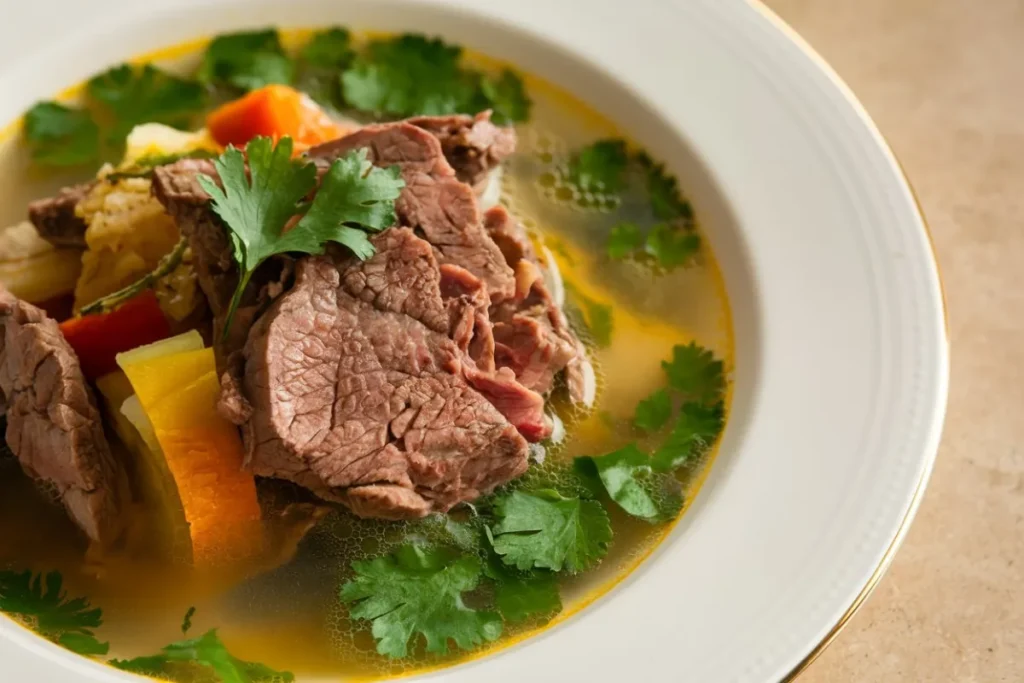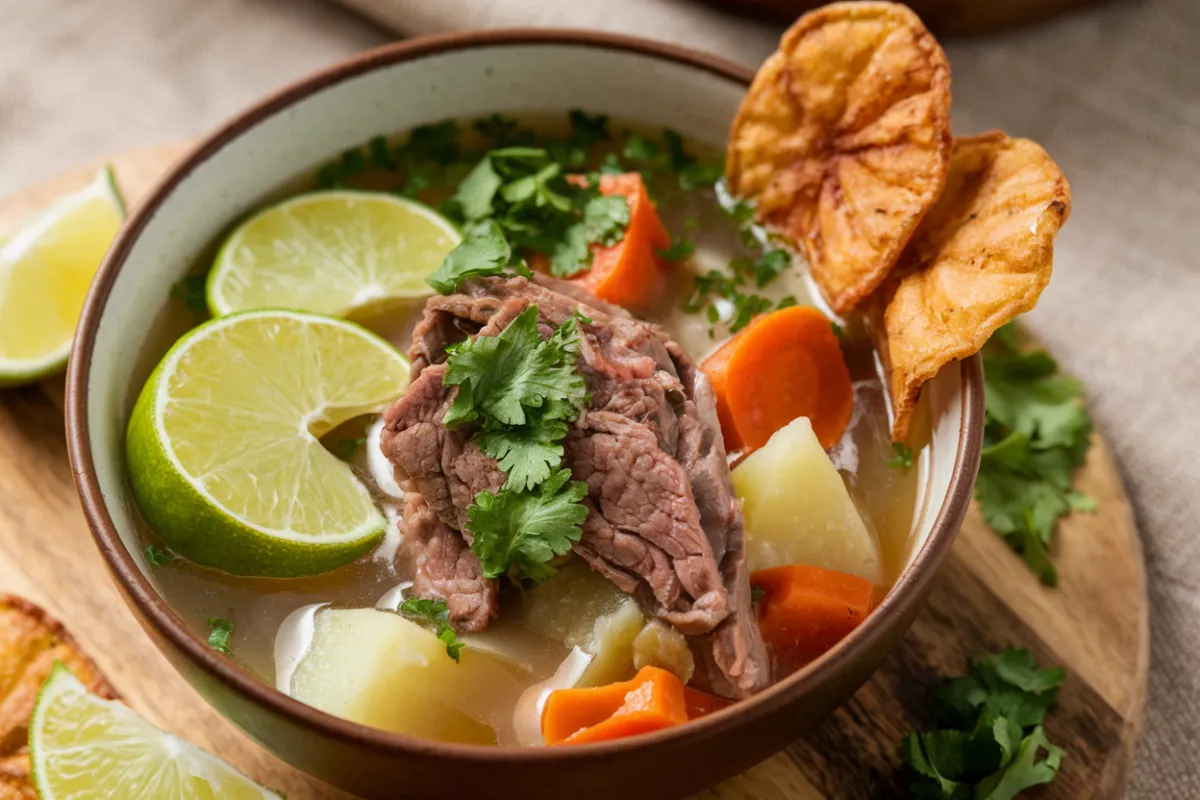Caldo de Res, also known as Mexican Beef Soup, is a hearty, flavorful dish that holds a cherished place in Mexican cuisine. It’s a soup that warms the soul and fills the stomach, perfect for cold days or when in need of comfort food. Made with chunks of beef, fresh vegetables, and a richly seasoned broth, this traditional dish offers a perfect balance of flavors, textures, and nutrients.
In this comprehensive guide, we will explore everything about Caldo de Res, including its core ingredients, variations, preparation methods, serving suggestions, and the health benefits associated with this delicious dish. We’ll also answer frequently asked questions and provide helpful tips for making the perfect Caldo de Res at home.
Part 1: Introduction and Core Ingredients
Introduction to Caldo de Res
Caldo de Res is a traditional Mexican soup that showcases the culinary heritage of the country. It’s a dish deeply rooted in rural Mexico, often prepared to provide warmth, comfort, and sustenance to families. Its popularity has spread beyond Mexico, becoming a beloved dish among food enthusiasts worldwide.
The soup typically consists of a rich beef broth with chunks of tender beef and a variety of fresh vegetables. The ingredients are slowly simmered to create a flavorful and aromatic broth, resulting in a satisfying dish that is both nutritious and filling. The simplicity of the ingredients allows for many variations, making it a versatile dish that can be adapted to suit different tastes and dietary needs.
Core Ingredients in Caldo de Res
To make an authentic Caldo de Res, it is essential to use high-quality ingredients that contribute to the soup’s depth of flavor and hearty texture. Here’s a breakdown of the core components:
Beef
The beef is the primary protein in Caldo de Res, and choosing the right cut is crucial for achieving the best flavor and texture. Common cuts used in the soup include:
- Beef Shank: This cut is ideal for soup because it contains connective tissue and marrow that break down during cooking, adding a rich flavor and gelatinous texture to the broth. The slow simmering process helps tenderize the beef, making it soft and succulent.
- Short Ribs: Short ribs are another excellent choice, providing a deeper, richer flavor and a slightly fattier texture that enhances the overall heartiness of the soup.
- Chuck Roast: Some variations use chuck roast, a cut known for its balance of fat and meat, which also contributes to a flavorful and tender result.
When preparing the beef, it is essential to sear it properly to enhance the flavor and create a deep, rich color for the broth. The beef is often cooked with bones to add an extra layer of flavor.
Vegetables

A variety of vegetables are used in Caldo de Res, each adding unique flavors, textures, and nutritional benefits to the dish:
- Corn on the Cob: Fresh corn adds a natural sweetness and a slightly chewy texture, balancing the savory elements of the soup.
- Potatoes: Potatoes contribute a starchy element, making the soup more filling and providing a creamy texture when cooked.
- Carrots: Carrots offer a mild sweetness and are packed with vitamins and antioxidants, contributing to the soup’s nutritional profile.
- Zucchini: Zucchini adds a subtle flavor and boosts the soup’s nutrient content with vitamins A and C.
- Cabbage: Cabbage provides bulk and a slightly peppery flavor, enhancing the overall texture and adding a crunchy bite.
Fresh, seasonal vegetables are preferred to ensure optimal flavor and vibrant color in the soup. For tips on incorporating different vegetables into your Mexican dishes, check out the Mexican Food Guide.
Herbs and Spices
Herbs and spices play a vital role in bringing out the flavors in Caldo de Res:
- Cilantro: Often added at the end for a burst of freshness and a hint of citrus flavor.
- Bay Leaves: Provide a subtle earthy undertone that complements the beef.
- Garlic and Onion: Essential aromatics that form the base of the soup’s flavor.
- Cumin and Oregano: Add warmth and depth to the broth, giving it a distinctive Mexican flavor.
Broth or Stock Base
The base of Caldo de Res is a rich, flavorful beef broth. Traditionally, homemade broth is used to achieve the best results. Here’s how to prepare it:
- Simmer Beef Bones: Start by simmering beef bones with onions, garlic, bay leaves, and peppercorns.
- Skim Impurities: Periodically skim any impurities that rise to the surface to keep the broth clear.
- Simmer for Hours: Allow the broth to simmer for several hours, which helps to extract all the flavors and nutrients from the bones and aromatics.
For a detailed guide on making beef broth at home, refer to How to Make Beef Broth.
Optional Ingredients and Variations
Caldo de Res is a versatile dish, and many variations exist based on regional preferences or personal tastes:
- Alternative Vegetables: Some recipes may include ingredients like chayote, squash, green beans, or even tomatoes for added texture and flavor.
- Regional Variations: Different regions of Mexico may use specific vegetables or additional spices to give their version of Caldo de Res a unique twist. For example, in some areas, it’s common to add chili peppers for a spicier kick.
- Personal Twists: Cooks often add their unique ingredients, such as lime juice for a tangy flavor or avocados as a garnish for extra creaminess.
Part 2: Preparation, Serving, and FAQs
Step-by-Step Preparation Guide
Creating an authentic Caldo de Res at home involves careful preparation and a slow cooking process to ensure all flavors meld together perfectly. Here’s a step-by-step guide:
Preparing the Ingredients
Before you start cooking, it is crucial to prepare all your ingredients:
- Beef: Cut the beef into large chunks and season with salt and pepper. Let it sit for a few minutes to absorb the seasoning.
- Vegetables: Chop the vegetables into bite-sized pieces to ensure even cooking. Cut the corn into smaller segments if using whole cobs.
- Herbs and Spices: Gather fresh herbs and measure out spices for easy addition during cooking.
Cooking Instructions
- Sear the Beef: Heat a large pot over medium-high heat and add oil. Sear the beef until it is browned on all sides. This step enhances the flavor by creating a caramelized crust on the meat.
- Add Broth and Aromatics: Pour in the beef broth and add onions, garlic, and bay leaves. Bring to a boil, then reduce to a simmer. The broth will start to absorb the flavors of the beef and aromatics.
- Simmer the Soup: Let the soup simmer for about an hour, or until the beef becomes tender. The slow cooking process helps break down the collagen in the beef, creating a rich, gelatinous texture in the broth.
- Add Vegetables: Add the potatoes, carrots, corn, zucchini, and cabbage. Continue to simmer until the vegetables are cooked through and have absorbed the flavors of the broth.
- Season and Serve: Taste the soup and adjust seasoning with salt and pepper. Garnish with fresh cilantro and serve hot.
Tips for Enhancing the Flavor
- Use Fresh Ingredients: Always use fresh vegetables and herbs for the best flavor.
- Experiment with Additions: Add lime juice, chili peppers, or other spices to adjust the taste to your preference.
- Slow Cooking is Key: Allowing the soup to simmer slowly ensures that the flavors meld together, creating a richer taste.
Serving Suggestions
Caldo de Res is traditionally served with a variety of accompaniments to enhance the dining experience. Here are some suggestions:
- Tortillas and Rice: Serve with warm corn tortillas or white rice to soak up the flavorful broth.
- Garnishes: Top with freshly chopped cilantro, diced onions, lime wedges, and slices of avocado for added flavor and texture.
- Side Dishes: Pair with a light salad or a simple side of refried beans to complete the meal.
Leftovers can be stored in the refrigerator for up to three days. Reheat gently on the stove to maintain the soup’s flavors and textures.
Health Benefits of Caldo de Res
Caldo de Res is not only a flavorful dish but also offers numerous health benefits:
- Rich in Protein: The beef provides a high-quality source of protein, which is essential for muscle growth and repair.
- Vitamins and Minerals: The vegetables used in the soup, such as carrots, zucchini, and cabbage, are rich in vitamins A, C, and K, as well as minerals like potassium, magnesium, and calcium.
- Boosts Immunity: Ingredients like garlic, onions, and cilantro are known for their immune-boosting properties.
- Low in Calories: Despite being hearty and filling, Caldo de Res is relatively low in calories, making it an excellent option for a balanced diet.
FAQs: People Also Ask
- What meat is used in Caldo de Res?
Caldo de Res typically uses cuts like beef shank, short ribs, or chuck roast, which provide rich flavor and tender texture. - Can I use other types of meat in Caldo de Res?
Yes, while traditional recipes call for beef, you can substitute with other meats like chicken or pork. However, this will alter the traditional flavor profile of the soup. - How long does Caldo de Res take to cook?
The cooking time varies depending on the cut of beef and the desired tenderness, but it generally takes about 1.5 to 2 hours. - What can I serve with Caldo de Res?
Common accompaniments include rice, tortillas, lime wedges, chopped onions, and fresh cilantro. - Is Caldo de Res healthy?
Yes, Caldo de Res is a nutrient-dense soup that is rich in protein, vitamins, and minerals while being low in calories. - How do I store and reheat Caldo de Res?
Store in an airtight container in the refrigerator for up to three days. Reheat gently on the stove or in the microwave.
Conclusion
Caldo de Res is a versatile and nutritious dish that captures the essence of Mexican comfort food. With its rich broth, tender beef, and a variety of vegetables, it provides a wholesome and satisfying meal that appeals to all palates. Whether you’re a seasoned cook or a beginner looking to explore Mexican cuisine, making Caldo de Res at home is a rewarding experience.
By following this guide, you can create an authentic Caldo de Res that embodies traditional flavors while allowing room for personal touches. Gather your ingredients, take your time with the preparation, and enjoy the heartwarming taste of this beloved Mexican soup.

